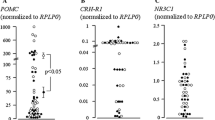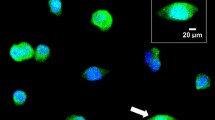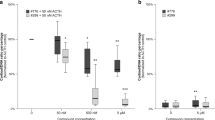Abstract
Secretion of hormones by the anterior pituitary gland can be stimulated or inhibited by paracrine factors that are produced during inflammatory reactions. The inflammation cytokine interferon-gamma (IFN-γ) is known to inhibit corticotropin-releasing factor (CRF)-stimulated adrenocorticotropin (ACTH) release but its signaling mechanism is not yet known. Using rat anterior pituitary, we previously demonstrated that the CXC chemokine ligand 10 (CXCL10), known as interferon-γ (IFN-γ) inducible protein 10 kDa, is expressed in dendritic cell-like S100β protein-positive (DC-like S100β-positive) cells and that its receptor CXCR3 is expressed in ACTH-producing cells. DC-like S100β-positive cells are a subpopulation of folliculo-stellate cells in the anterior pituitary. In the present study, we examine whether CXCL10/CXCR3 signaling between DC-like S100β-positive cells and ACTH-producing cells mediates inhibition of CRF-activated ACTH-release by IFN-γ, using a CXCR3 antagonist in the primary pituitary cell culture. We found that IFN-γ up-regulated Cxcl10 expression via JAK/STAT signaling and proopiomelanocortin (Pomc) expression, while we reconfirmed that IFN-γ inhibits CRF-stimulated ACTH-release. Next, we used a CXCR3 agonist in primary culture to analyze whether CXCL10 induces Pomc-expression and ACTH-release using a CXCR3 agonist in the primary culture. The CXCR3 agonist significantly stimulated Pomc-expression and inhibited CRF-induced ACTH-release, while ACTH-release in the absence of CRF did not change. Thus, the present study leads us to an assumption that CXCL10/CXCR3 signaling mediates inhibition of the CRF-stimulated ACTH-release by IFN-γ. Our findings bring us to an assumption that CXCL10 from DC-like S100β-positive cells acts as a local modulator of ACTH-release during inflammation.







Similar content being viewed by others
References
Allaerts W, Vankelecom H (2005) History and perspectives of pituitary folliculo-stellate cell research. Eur J Endocrinol 153:1–12
Allaerts W, Fluitsma DM, Hoefsmit EC, Jeucken PH, Morreau H, Bosman FT, Drexhage HA (1996) Immunohistochemical, morphological and ultrastructural resemblance between dendritic cells and folliculo-stellate cells in normal human and rat anterior pituitaries. J Neuroendocrinol 8:17–29
Blouin CM, Lamaze C (2013) Interferon gamma receptor: the beginning of the journey. Front Immunol 4:267
Blumenfeld Z, Jaffe RB (1986) Hypophysiotropic and neuromodulatory regulation of adrenocorticotropin in the human fetal pituitary gland. J Clin Invest 78:288–294
Charo IF, Ransohoff RM (2006) The many roles of chemokines and chemokine receptors in inflammation. N Engl J Med 354:610–621
Gloddek J, Lohrer P, Stalla J, Arzt E, Stalla GK, Renner U (2001) The intrapituitary stimulatory effect of lipopolysaccharide on ACTH secretion is mediated by paracrine-acting IL-6. Exp Clin Endocrinol Diabetes 109:410–415
Höfler H, Denk H, Walter GF (1984) Immunohistochemical demonstration of cytokeratins in endocrine cells of the human pituitary gland and in pituitary adenomas. Virchows Arch A 404:359–368
Horiguchi K, Fujiwara K, Yoshida S, Higuchi M, Tsukada T, Kanno N, Yashiro T, Tateno K, Ohsako S, Kato T, Kato Y (2014a) Isolation of dendritic cell-like S100β-positive cells in rat anterior pituitary gland. Cell Tissue Res 357:301–308
Horiguchi K, Fujiwara K, Higuchi M, Yoshida S, Tsukada T, Ueharu H, Chen M, Hasegawa R, Takigami S, Ohsako S, Yashiro T, Kato T, Kato Y (2014b) Expression of chemokine CXCL10 in dendritic cell-like S100β-positive cells in rat anterior pituitary gland. Cell Tissue Res 357:757–765
Horiguchi K, Higuchi M, Yoshida S, Nakakura T, Tateno K, Hasegawa R, Takigami S, Ohsako S, Kato T, Kato Y (2014c) Proton receptor GPR68 expression in dendritic cell-like S100β-positive cells of rat anterior pituitary gland: GPR68 induces interleukin-6 gene expression in extracellular acidification. Cell Tissue Res 358:515–525
Itakura E, Odaira K, Yokoyama K, Osuna M, Hara T, Inoue K (2007) Generation of transgenic rats expressing green fluorescent protein in S-100beta-producing pituitary folliculo-stellate cells and brain astrocytes. Endocrinology 148:1518–1523
Jenh CH, Cox MA, Cui L, Reich EP, Sullivan L, Chen SC, Kinsley D, Qian S, Kim SH, Rosenblum S, Kozlowski J, Fine JS, Zavodny PJ, Lundell D (2012) A selective and potent CXCR3 antagonist SCH 546738 attenuates the development of autoimmune diseases and delays graft rejection. BMC Immunol 13:2. doi:10.1186/1471-2172-13-2
Jenks BG (2009) Regulation of proopiomelanocortin gene expression: an overview of the signaling cascades, transcription factors, and responsive elements involved. Ann NY Acad Sci 1163:17–30
Kageyama K, Li C, Vale WW (2003) Corticotropin-releasing factor receptor type 2 messenger ribonucleic acid in rat pituitary: localization and regulation by immune challenge, restraint stress, and glucocorticoids. Endocrinology 144:1524–1532
Karalis K, Sano H, Redwine J, Listwak S, Wilder RL, Chrousos GP (1991) Autocrine or paracrine inflammatory actions of corticotropin-releasing hormone in vivo. Science 254:421–423
Khan IA, MacLean JA, Lee FS, Casciotti L, DeHaan E, Schwartzman JD, Luster AD (2000) Resolution of ST-segment elevation after streptokinase therapy in anterior versus inferior wall myocardial infarction. Clin Cardiol 23:490–494
Lo BK, Yu M, Zloty D, Cowan B, Shapiro J, McElwee KJ (2010) CXCR3/ligands are significantly involved in the tumorigenesis of basal cell carcinomas. Am J Pathol 176:2435–2446
Luster AD, Ravetch JV (1987) Biochemical characterization of a gamma interferon-inducible cytokine (IP-10). J Exp Med 166:1084–1097
Moore BW (1965) A soluble protein characteristic of the nervous system. Biochem Biophys Res Commun 19:739–744
Qi XF, Kim DH, Yoon YS, Jin D, Huang XZ, Li JH, Deung YK, Lee KJ (2009) Essential involvement of cross-talk between IFN-gamma and TNF-alpha in CXCL10 production in human THP-1 monocytes. J Cell Physiol 220:690–697
Rot A, von Andrian UH (2004) Chemokines in innate and adaptive host defense: basic chemokinese grammar for immune cells. Annu Rev Immunol 22:891–928
Soji T, Herbert DC (1989) Intercellular communication between rat anterior pituitary cells. Anat Rec 224:523–533
Stroke IL, Cole AG, Simhadri S, Brescia MR, Desai M, Zhang JJ, Merritt JR, Appell KC, Henderson I, Webb ML (2006) Identification of CXCR3 receptor agonists in combinatorial small-molecule libraries. Biochem Biophys Res Commun 349:221–228
Sui Y, Stehno-Bittel L, Li S, Loganathan R, Dhillon NK, Pinson D, Nath A, Kolson D, Narayan O, Buch S (2006) CXCL10-induced cell death in neurons: role of calcium dysregulation. Eur J Neurosci 23:957–964
Vankelecom H, Carmeliet P, Van Damme J, Billiau A, Denef C (1989) Production of interleukin-6 by folliculo-stellate cells of the anterior pituitary gland in a histiotypic cell aggregate culture system. Neuroendocrinology 49:102–106
Vankelecom H, Carmeliet P, Heremans H, Van Damme J, Dijkmans R, Billiau A, Denef C (1990) Interferon-gamma inhibits stimulated adrenocorticotropin, prolactin, and growth hormone secretion in normal rat anterior pituitary cell cultures. Endocrinology 126:2919–2926
Vankelecom H, Andries M, Billiau A, Denef C (1992) Evidence that folliculo-stellate cells mediate the inhibitory effect of interferon-gamma on hormone secretion in rat anterior pituitary cell cultures. Endocrinology 130:3537–3546
Vila-Porcile E (1972) The network of the folliculo-stellate cells and the follicles of the adenohypophysis in the rat (pars distalis). Z Zellforch Microsk Anat Histochem 129:328–369
Watling D, Guschin D, Müller M, Silvennoinen O, Witthuhn BA, Quelle FW, Rogers NC, Schindler C, Stark GR, Ihle JN, Kerr IM (1993) Complementation by the protein tyrosine kinase JAK2 of a mutant cell line defective in the interferon-& gamma; signal transduction pathway. Nature 366:166–170
Yoshida S, Kato T, Susa T, Cai LY, Nakayama M, Kato Y (2009) PROP1 coexists with SOX2 and induces PIT1-commitment cells. Biochem Biophys Res Commun 385:11–15
Yoshida S, Kato T, Yako H, Susa T, Cai LY, Osuna M, Inoue K, Kato Y (2011) Significant quantitative and qualitative transition in pituitary stem / progenitor cells occurs during the postnatal development of the rat anterior pituitary. J Neuroendocrinol 23:933–943
Zacharowski K, Zacharowski PA, Koch A, Baban A, Tran N, Berkels R, Papewalis C, Schulze-Osthoff K, Knuefermann P, Zähringer U, Schumann RR, Rettori V, McCann SM, Bornstein SR (2006) Toll-like receptor 4 plays a crucial role in the immune-adrenal response to systemic inflammatory response syndrome. Proc Natl Acad Sci U S A 103:6392–6397
Zlotnik A, Yoshie O (2000) Chemokines: a new classification system and their role in immunity. Immunity 12:121–127
Author information
Authors and Affiliations
Corresponding author
Ethics declarations
Conflict of interest
The authors have no conflict of interest that might prejudice the impartiality of this research.
Funding
This work was supported by a Grant-in-Aid for Young Scientists (B) (no. 25860148 to K.H.) from the Ministry of Education, Culture, Sports, Science, and Technology of Japan and by the Kyorin University Individual Investigator Award from the Faculty of Health Sciences, Kyorin University. It was also partially supported by JSPS KAKENHI Grants (nos. 21380184 to Y.K. and 24580435 to T.K.), by a MEXT-supported Program for the Strategic Research Foundation at Private Universities, 2014–2018 and by the Meiji University International Institute for BioResource Research (MUIIR).
Electronic supplementary material
Below is the link to the electronic supplementary material.
Fig. S1
The expression of Ifng, Ifngr1 and Ifngr2 in S100β-positive cells. Their mRNA levels, as determined by real-time PCR, were normalized with an internal control b-actin (mean ± SEM, n = 3). (a) Ifng, Ifngr1 and Ifngr2 mRNA levels in the rat anterior pituitary gland (anterior pituitary gland) of adult. (b) Ifngr1 and Ifngr2 mRNA levels in S100β-positive cells (S100β-positive cells). N.D., Not detected. (GIF 17 kb)
Table S1
Primers for real-time RT-PCR. (GIF 75 kb)
Rights and permissions
About this article
Cite this article
Horiguchi, K., Fujiwara, K., Tsukada, T. et al. CXCL10/CXCR3 signaling mediates inhibitory action by interferon-gamma on CRF-stimulated adrenocorticotropic hormone (ACTH) release. Cell Tissue Res 364, 395–404 (2016). https://doi.org/10.1007/s00441-015-2317-2
Received:
Accepted:
Published:
Issue Date:
DOI: https://doi.org/10.1007/s00441-015-2317-2




